大学物理实验课教学大纲
大学物理试验教学大纲
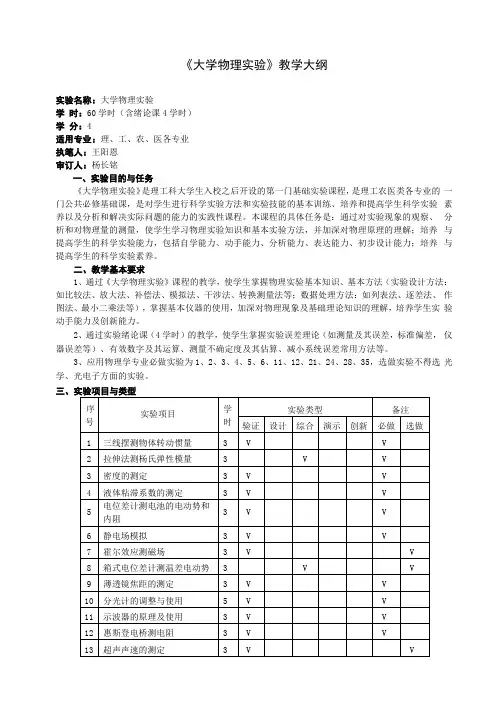
《大学物理实验》教学大纲实验名称:大学物理实验学时:60学时(含绪论课4学时)学分:4适用专业:理、工、农、医各专业执笔人:王阳恩审订人:杨长铭一、实验目的与任务《大学物理实验》是理工科大学生入校之后开设的第一门基础实验课程,是理工农医类各专业的一门公共必修基础课,是对学生进行科学实验方法和实验技能的基本训练、培养和提高学生科学实验素养以及分析和解决实际问题的能力的实践性课程。
本课程的具体任务是:通过对实验现象的观察、分析和对物理量的测量,使学生学习物理实验知识和基本实验方法,并加深对物理原理的理解;培养与提高学生的科学实验能力,包括自学能力、动手能力、分析能力、表达能力、初步设计能力;培养与提高学生的科学实验素养。
二、教学基本要求1、通过《大学物理实验》课程的教学,使学生掌握物理实验基本知识、基本方法(实验设计方法:如比较法、放大法、补偿法、模拟法、干涉法、转换测量法等;数据处理方法:如列表法、逐差法、作图法、最小二乘法等),掌握基本仪器的使用,加深对物理现象及基础理论知识的理解,培养学生实验动手能力及创新能力。
2、通过实验绪论课(4学时)的教学,使学生掌握实验误差理论(如测量及其误差,标准偏差,仪器误差等)、有效数字及其运算、测量不确定度及其估算、减小系统误差常用方法等。
3、应用物理学专业必做实验为1、2、3、4、5、6、11、12、21、24、28、35,选做实验不得选光学、光电子方面的实验。
实验一三线摆测物体转动惯量(3学时)1、目的要求研究刚体转动时合外力矩与刚体转动角加速度的关系,考查刚体的质量分布改变时,对转动惯量的影响。
2、方法原理刚体转动定律:M = I P ,平行轴定律:I = 10 + mx23、主要实验仪器及材料三线摆,秒表,游标卡尺,直尺。
4、掌握要点三线摆的调节与使用。
5、实验内容:(1)测量出三线摆转动的周期、各部分的尺寸,。
(2)改变重物的位置,考查质量分布对转动的影响。
《大学物理实验》教学大纲
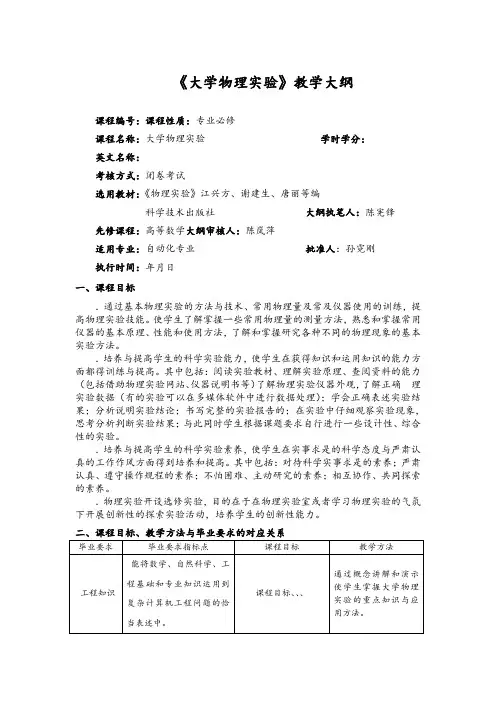
《大学物理实验》教学大纲课程编号:课程性质:专业必修课程名称:大学物理实验学时学分:英文名称:考核方式:闭卷考试选用教材:《物理实验》江兴方、谢建生、唐丽等编科学技术出版社大纲执笔人:陈宪锋先修课程:高等数学大纲审核人:陈岚萍适用专业:自动化专业批准人:孙霓刚执行时间:年月日一、课程目标.通过基本物理实验的方法与技术、常用物理量及常及仪器使用的训练,提高物理实验技能。
使学生了解掌握一些常用物理量的测量方法,熟悉和掌握常用仪器的基本原理、性能和使用方法,了解和掌握研究各种不同的物理现象的基本实验方法。
.培养与提高学生的科学实验能力,使学生在获得知识和运用知识的能力方面都得训练与提高。
其中包括:阅读实验教材、理解实验原理、查阅资料的能力(包括借助物理实验网站、仪器说明书等)了解物理实验仪器外观,了解正确理实验数据(有的实验可以在多媒体软件中进行数据处理);学会正确表述实验结果;分析说明实验结论;书写完整的实验报告的;在实验中仔细观察实验现象,思考分析判断实验结果;与此同时学生根据课题要求自行进行一些设计性、综合性的实验。
.培养与提高学生的科学实验素养,使学生在实事求是的科学态度与严肃认真的工作作风方面得到培养和提高。
其中包括:对待科学实事求是的素养;严肃认真、遵守操作规程的素养;不怕困难、主动研究的素养;相互协作、共同探索的素养。
.物理实验开设选修实验,目的在于在物理实验室或者学习物理实验的气氛下开展创新性的探索实验活动,培养学生的创新性能力。
二、课程目标、教学方法与毕业要求的对应关系三、教学内容及学时分配绪论课(学时)物理实验的作用与地位,实验的基本程序,测量、误差与不确定度,有效数字,随机误差的统计处理,系统误差的判断和处理,实验结果的不确定度表示。
实验课(学时).实验类型有:①演示;②验证;③综合;④设计; ⑤其它;.实验要求有:①必修;②选修;③其他四、实验成绩的考核与评定办法实验课程成绩的考核分为平时成绩和实验报告两部分:平时成绩:包括学生出勤、实验纪律和回答问题等成绩,占总成绩的。
大学物理实验课程教学大纲物理实验中心河北工业大学
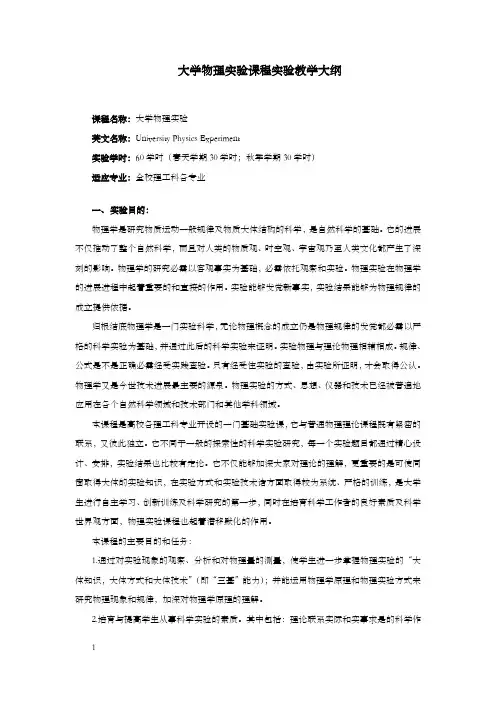
大学物理实验课程实验教学大纲课程名称:大学物理实验英文名称:University Physics Experiment实验学时:60学时(春天学期30学时;秋季学期30学时)适应专业:全校理工科各专业一、实验目的:物理学是研究物质运动一般规律及物质大体结构的科学,是自然科学的基础。
它的进展不仅推动了整个自然科学,而且对人类的物质观、时空观、宇宙观乃至人类文化都产生了深刻的影响。
物理学的研究必需以客观事实为基础,必需依托观察和实验。
物理实验在物理学的进展进程中起着重要的和直接的作用。
实验能够发觉新事实,实验结果能够为物理规律的成立提供依据。
归根结底物理学是一门实验科学,无论物理概念的成立仍是物理规律的发觉都必需以严格的科学实验为基础,并通过此后的科学实验来证明。
实验物理与理论物理相辅相成。
规律、公式是不是正确必需经受实践查验。
只有经受住实验的查验,由实验所证明,才会取得公认。
物理学又是今世技术进展最主要的源泉。
物理实验的方式、思想、仪器和技术已经被普遍地应用在各个自然科学领域和技术部门和其他学科领域。
本课程是高校各理工科专业开设的一门基础实验课,它与普通物理理论课程既有紧密的联系,又彼此独立。
它不同于一般的探索性的科学实验研究,每一个实验题目都通过精心设计、安排,实验结果也比较有定论。
它不仅能够加深大家对理论的理解,更重要的是可使同窗取得大体的实验知识,在实验方式和实验技术诸方面取得较为系统、严格的训练,是大学生进行自主学习、创新训练及科学研究的第一步,同时在培育科学工作者的良好素质及科学世界观方面,物理实验课程也起着潜移默化的作用。
本课程的主要目的和任务:1.通过对实验现象的观察、分析和对物理量的测量,使学生进一步掌握物理实验的“大体知识,大体方式和大体技术”(即“三基”能力);并能运用物理学原理和物理实验方式来研究物理现象和规律,加深对物理学原理的理解。
2.培育与提高学生从事科学实验的素质。
其中包括:理论联系实际和实事求是的科学作风;严肃认真的工作态度;不怕困难,主动进取的探索精神;遵守操作规程,珍惜公共财物的优良道德;和在实验进程中彼此协作,一路探索的团队合作精神。
大学物理实验课程教学大纲
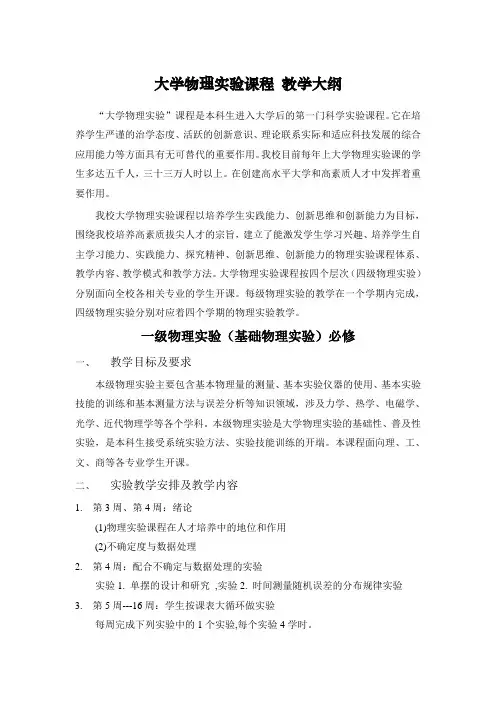
大学物理实验课程教学大纲“大学物理实验”课程是本科生进入大学后的第一门科学实验课程。
它在培养学生严谨的治学态度、活跃的创新意识、理论联系实际和适应科技发展的综合应用能力等方面具有无可替代的重要作用。
我校目前每年上大学物理实验课的学生多达五千人,三十三万人时以上。
在创建高水平大学和高素质人才中发挥着重要作用。
我校大学物理实验课程以培养学生实践能力、创新思维和创新能力为目标,围绕我校培养高素质拔尖人才的宗旨,建立了能激发学生学习兴趣、培养学生自主学习能力、实践能力、探究精神、创新思维、创新能力的物理实验课程体系、教学内容、教学模式和教学方法。
大学物理实验课程按四个层次(四级物理实验)分别面向全校各相关专业的学生开课。
每级物理实验的教学在一个学期内完成,四级物理实验分别对应着四个学期的物理实验教学。
一级物理实验(基础物理实验)必修一、教学目标及要求本级物理实验主要包含基本物理量的测量、基本实验仪器的使用、基本实验技能的训练和基本测量方法与误差分析等知识领域,涉及力学、热学、电磁学、光学、近代物理学等各个学科。
本级物理实验是大学物理实验的基础性、普及性实验,是本科生接受系统实验方法、实验技能训练的开端。
本课程面向理、工、文、商等各专业学生开课。
二、实验教学安排及教学内容1.第3周、第4周:绪论(1)物理实验课程在人才培养中的地位和作用(2)不确定度与数据处理2.第4周:配合不确定与数据处理的实验实验1. 单摆的设计和研究,实验2. 时间测量随机误差的分布规律实验3.第5周---16周:学生按课表大循环做实验每周完成下列实验中的1个实验,每个实验4学时。
“示波器测量时间”、“用天平测量质量”、“直流电表和直流测量电路”、“用热敏电阻测量温度”、“半导体温度计的设计与制作”、“声速的测量”、“直线运动与碰撞”、“钢丝杨氏模量的测量”、“切变模量的测量”、“固体比热容的测量”、“表面张力系数的测定”、“落球法测定液体的粘度”、“交流电及整流滤波电路”、“测量螺线管的磁场”、“透镜参数的测量”、“分光计的调节与使用(8学时)”、“干涉法测微小量”、“用密立根油滴实验测电子电荷”、“光电效应法测普朗克常量”4.第17周:考试按课表大循环学生自主设计完成一个实验,当场交实验报告。
《大学物理实验AⅠ、AⅡ》课程教学大纲
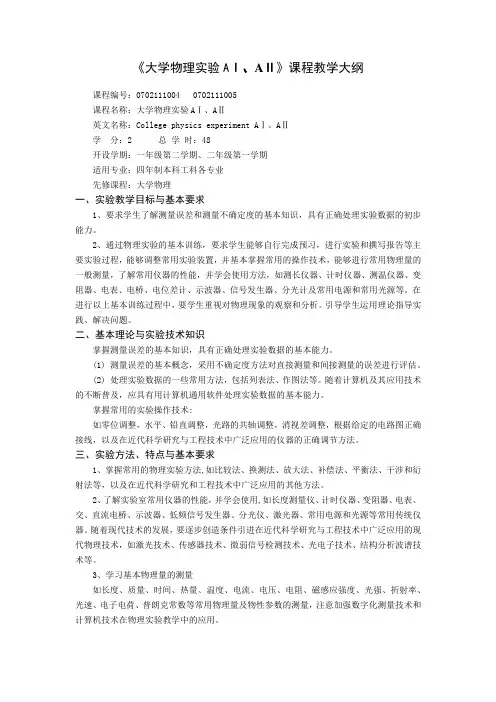
《大学物理实验AⅠ、AⅡ》课程教学大纲课程编号:0702111004 0702111005课程名称:大学物理实验AⅠ、AⅡ英文名称:College physics experiment AⅠ、AⅡ学分:2 总学时:48开设学期:一年级第二学期、二年级第一学期适用专业:四年制本科工科各专业先修课程:大学物理一、实验教学目标与基本要求1、要求学生了解测量误差和测量不确定度的基本知识,具有正确处理实验数据的初步能力。
2、通过物理实验的基本训练,要求学生能够自行完成预习,进行实验和撰写报告等主要实验过程,能够调整常用实验装置,并基本掌握常用的操作技术,能够进行常用物理量的一般测量,了解常用仪器的性能,并学会使用方法,如测长仪器、计时仪器、测温仪器、变阻器、电表、电桥、电位差计、示波器、信号发生器、分光计及常用电源和常用光源等。
在进行以上基本训练过程中,要学生重视对物理现象的观察和分析。
引导学生运用理论指导实践、解决问题。
二、基本理论与实验技术知识掌握测量误差的基本知识,具有正确处理实验数据的基本能力。
(1) 测量误差的基本概念,采用不确定度方法对直接测量和间接测量的误差进行评估。
(2) 处理实验数据的一些常用方法,包括列表法、作图法等。
随着计算机及其应用技术的不断普及,应具有用计算机通用软件处理实验数据的基本能力。
掌握常用的实验操作技术:如零位调整,水平、铅直调整,光路的共轴调整,消视差调整,根据给定的电路图正确接线,以及在近代科学研究与工程技术中广泛应用的仪器的正确调节方法。
三、实验方法、特点与基本要求1、掌握常用的物理实验方法,如比较法、换测法、放大法、补偿法、平衡法、干涉和衍射法等,以及在近代科学研究和工程技术中广泛应用的其他方法。
2、了解实验室常用仪器的性能,并学会使用,如长度测量仪、计时仪器、变阻器、电表、交、直流电桥、示波器、低频信号发生器、分光仪、激光器、常用电源和光源等常用传统仪器。
随着现代技术的发展,要逐步创造条件引进在近代科学研究与工程技术中广泛应用的现代物理技术,如激光技术、传感器技术、微弱信号检测技术、光电子技术、结构分析波谱技术等。
《大学物理实验》(B类)教学大纲
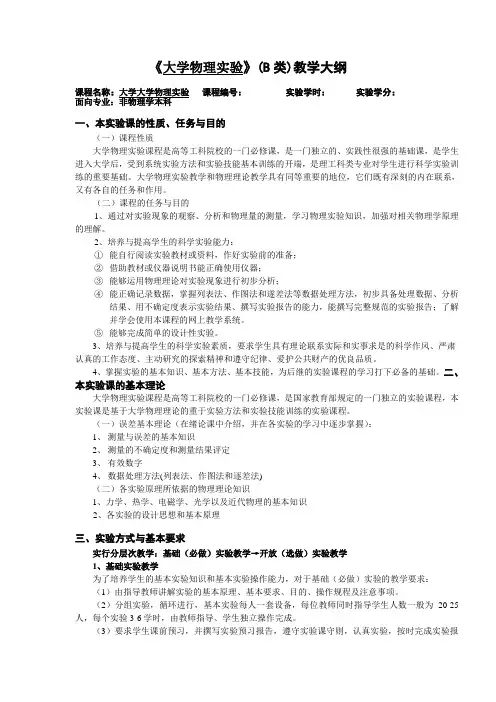
《大学物理实验》(B类)教学大纲课程名称:大学大学物理实验课程编号:实验学时:实验学分:面向专业:非物理学本科一、本实验课的性质、任务与目的(一)课程性质大学物理实验课程是高等工科院校的一门必修课,是一门独立的、实践性很强的基础课,是学生进入大学后,受到系统实验方法和实验技能基本训练的开端,是理工科类专业对学生进行科学实验训练的重要基础。
大学物理实验教学和物理理论教学具有同等重要的地位,它们既有深刻的内在联系,又有各自的任务和作用。
(二)课程的任务与目的1、通过对实验现象的观察、分析和物理量的测量,学习物理实验知识,加强对相关物理学原理的理解。
2、培养与提高学生的科学实验能力:①能自行阅读实验教材或资料,作好实验前的准备;②借助教材或仪器说明书能正确使用仪器;③能够运用物理理论对实验现象进行初步分析;④能正确记录数据,掌握列表法、作图法和遂差法等数据处理方法,初步具备处理数据、分析结果、用不确定度表示实验结果、撰写实验报告的能力,能撰写完整规范的实验报告;了解并学会使用本课程的网上教学系统。
⑤能够完成简单的设计性实验。
3、培养与提高学生的科学实验素质,要求学生具有理论联系实际和实事求是的科学作风、严肃认真的工作态度、主动研究的探索精神和遵守纪律、爱护公共财产的优良品质。
4、掌握实验的基本知识、基本方法、基本技能,为后继的实验课程的学习打下必备的基础。
二、本实验课的基本理论大学物理实验课程是高等工科院校的一门必修课,是国家教育部规定的一门独立的实验课程,本实验课是基于大学物理理论的重于实验方法和实验技能训练的实验课程。
(一)误差基本理论(在绪论课中介绍,并在各实验的学习中逐步掌握):1、测量与误差的基本知识2、测量的不确定度和测量结果评定3、有效数字4、数据处理方法(列表法、作图法和逐差法)(二)各实验原理所依据的物理理论知识1、力学、热学、电磁学、光学以及近代物理的基本知识2、各实验的设计思想和基本原理三、实验方式与基本要求实行分层次教学:基础(必做)实验教学→开放(选做)实验教学1、基础实验教学为了培养学生的基本实验知识和基本实验操作能力,对于基础(必做)实验的教学要求:(1)由指导教师讲解实验的基本原理、基本要求、目的、操作规程及注意事项。
《大学物理实验》教学大纲(SyllabusofCollegePhysicsExperiment)
《大学物理实验》教学大纲(Syllabus of College PhysicsExperiment)Syllabus of College Physics Experiment(for engineering majors)Course number:Course English Name: Physical experiment of CollegeApplicable Specialty: Engineering Department: water conservancy, power, civil engineering, power machinery, medical department (five year) each professionDepartment of information: Surveying and mapping, remote sensing information, computer science, resources and environmental specialtiesSemester: This course takes two semesters (one, two)Class hour: 54 hoursCredits: 1.5Examination: examination scores of the experimental class with grades and final experimental skills examination of two parts: the scores accounted for 70% (including the report and experiment operation examination) accounted for 30% (including experimental operation and experimental results).Lecture room and teaching and research section: Physics Laboratory Center of physical science and Technology College (1), (two)First, the nature, purpose and task of the courseThe university physics experiment in higher school students in basic training of scientific experiment a compulsory basic course, is the beginning to accept system training experimental skills of students entering college, is an important basis for engineering students to conduct scientific experiments and training. It is the practical teaching link that students turn knowledge into ability through their own practice. It plays an important role in cultivating students' ability to observe, discover, analyze and research problems, and ultimately solve problems by means of experiments. Also for students to carry out scientific research independently, the design of experimental programs, selection, use of equipment and put forward new experimental topics; for further study of subsequent experimental courses to lay a good foundation. Its specific tasks are as follows:1, cultivate and improve students' scientific experimental literacy. Asked students to engage in scientific experiments should be conscientious, meticulous and strict working attitude and style of combining theory with practice, study and active exploration spirit, good discipline, unity and cooperation and take good care of public property.2, learn and master the use of experimental principles, methods to study some physical phenomena, conduct specific tests, drawconclusions, deepen the understanding of the principles of physics.3. Cultivate and improve students' ability of scientific experiment:(1) be able to read textbooks and materials, from the purpose of measurement requirements, the correct understanding of the scientific principles on the basis of good preparation before the experiment;(2) the correct selection and use of common instruments and the determination of reasonable experimental procedures can be carried out with the aid of teaching materials and instrument instructions;(3) basic training of experimental skills, familiar with the working principle, structure, performance, adjustment operation, observation, analysis and troubleshooting of common instruments;(4) good at using physics theory, observing the phenomena (general, normal, individual, abnormal) in experiment, and analyzing and judging the experimental phenomena preliminarily;(5) learn the correct recording and processing of experimental data, according to the requirements of drawing curves, the correct expression of the experimental results, writing experiment report qualified and the analysis of experimental methods, measuring instruments, the surrounding environment,the number of measurements and skills to influence the measurement result;(6) the experimental data can be consulted, and the simple design experiment can be done independently.Two, the course before classAdvanced mathematics and general physicsThree, the basic requirements of curriculum teaching1, in experiment teaching and introduces some appropriate physical experiment for students of the historical development, dialectical materialism, the world outlook and methodology of education, to enable students to understand the importance of scientific experiments, clear the course of physical experiment purpose, status, function and task.2, during the experiment, to educate students to develop good habits of experiment, training scientific style, linking theory with practice and realistic serious attitude and take good care of public property, follow the operating rules, abide by the rules of good moral character.3, the experimental introduction class should give students the basic knowledge of measurement error, uncertainty and experimental data processing, requiring students to master and apply in specific experiments,Cultivate students' ability to correctly analyze experimentalerrors and deal with experimental results.4, through the physical experiment system training, require students to do:(1) finish the experiment preparation before the class, write the preview report of the experiment (ask for self made data record form), conduct the experiment operation independently, and write the experiment report after class.(2) master the adjustment and operation technology of common physics experiment instruments. For example: zero calibration; horizontal, vertical balance adjustment; according to the correct circuit wiring diagram is given; the light path and high alignment etc..(3) master the commonly used experimental methods. Such as comparison method, amplification method, conversion measurement method, simulation method, balance method, compensation method, interference method and so on.(4) the measurement of common physical quantities. For example, length (including micro length and its change), angle, mass, time, force, pressure, temperature, heat, current, voltage, electromotive force, resistance, magnetic induction intensity, wavelength, refractive index, etc..(5) familiar with the performance and usage of common instruments. For example: vernier, micrometer, balance, stopwatch, thermometer (including thermocouple), DC voltage meter, current meter, electric meter, flow, pick up thepotentiometer, sliding rheostat, resistance box, universal oscilloscope, low-frequency signal source, reading microscope and telescope, raler reading spectrometer and the common light source (sodium lamp mercury, light and laser) etc..The design of experiments and comprehensive experiments by 5 students to complete a certain amount (including the modern physics experiment, etc.) determined to make students think, in the experimental method of measuring instrument selection and collocation, the measurement conditions by preliminary training.Four, the main content and specific requirements of the curriculumThis course is divided into introduction, basic experiment (60%), comprehensive and modern physics experiment (25%), design experiment four parts (15%). In the specific teaching arrangements, according to the professional situation and the number of hours of the following parts of the appropriate combination of content.Introduction classThe use of multimedia teaching of the introduction lesson form, measurement error and introduces the basic concepts of uncertainty and experimental results, effective digital processing method of uncertainty estimation, the common data, and the basic procedures and requirements. In the first experiment class, teachers divided classes, explained the experimental data, pre processed knowledge and the firstchapter exercises.Part 1 Basic ExperimentsExperiment 1 gravity acceleration measurementBy measuring the acceleration of gravity free fall 2-12-2 the pendulum is used to measure the acceleration of gravityExperiment 2 optical lever method to measure the young's modulus of steel wireMoment of inertia with torsion pendulum test 3 rigid body experimentExperiment 4 Determination of liquid viscosity coefficientThe surface tension coefficient of 5 by adruption measured liquidExperiment 6 Determination of thermal conductivity of poor conductorExperiment 7 sound velocity measurementExperimental 8 volt ampere method for measuring transistor characteristicsExperiment 9 DC bridge and its applicationThe principle and application of experiment 10 oscilloscopeExperiment 11 simulation of electrostatic fieldExperiment 12 alternating current bridgeExperiment 13 resonance of AC circuitExperiment 14 electromagnetic induction method to measure alternating magnetic fieldExperiment 15 Holzer effectExperiment 16 the measurement of the focal length of thin lensThe adjustment and use of spectrometer in experiment 17Application of equal thickness interference in experiment 18Experiment 19 diffraction gratingExperiment 20 analysis of polarized lightThe second part synthesis and modern physics experimentExperiment 21 measuring Young's modulus of metal by dynamic methodExperiment 22 ultrasonic thickness measurementExperiment 23 using nonlinear circuit to study chaoticphenomenaExperiment 24 unbalanced DC bridge and its application Steady state characteristics of RLC circuit in experiment 25 Transient characteristics of RLC circuit in experiment 26Fourier analysis of square wave electrical signals in experiment 27Experiment 28 Michelson interferometerExperiment 29 ultrasonic gratingExperiment 30 holographyExperiment 31 photoelectric effectExperiment 32 Franck Hertz experimentIn experiment 33, Millikan Oil Drop ExperimentExperiment 34 hydrogen atom spectrumThe third part is the design experimentExperiment 35 determination of the density of soluble particles in waterExperiment 36 measuring the volt ampere characteristic curveof small bulbExperiment 37 measuring the resistance of a given resistance wireExperiment 38 measuring resistance with potential difference meterIn experiment 39, the electromotive force and internal resistance of dry cell were measured by potential difference meterExperiment 40 modification and correction of ammeterExperiment 41 measuring the temperature coefficient of metal resistanceExperiment 42 design and manufacture of small power stabilized voltage power supplyExperiment 43 measuring the temperature characteristics of PN junction temperature sensorDesign and manufacture of digital thermometer in experiment 44Experiment 45 measuring the hysteresis loop of ferromagnetic materials by oscilloscopeExperiment 46 using Holzer device to measure the horizontal component of geomagnetic fieldExperiment 47 synthetic measurement of refractive index of optical materialsAssembly of internal focusing telescope in experiment 48 and determination of magnificationExperiment 49 measuring tiny length by Moire fringeFabrication of holographic grating in experiment 50In experiment 51, the light wavelength of sodium was measured by laser speckle photographyExperiment 52 measurement of optical fiber characteristic parametersExperiment 53 fiber optic temperature sensorExperiment 54 the application of computer in physics experimentLaser Doppler frequency shift measurementFive, teaching implementation and main contentEmphasis on experimental methods is a very important means of scientific research, such as comparative methods, amplification method, conversion measurement method, simulation method, compensation method and interference method used in physics experiments. Make the students realize the importance and necessity of the experiment course. In class, we should use questions and speeches, and take the students'independent operation as the main teaching method. In the course of teaching, we should consciously carry out the education of dialectical materialism and scientific methodology, and appropriately introduce some historical materials of physical experiments.The specific approach is strictly three:Good preview. Before class prepare to inform students to do experiment preparation, put forward request, teachers should check the students' Preview report before the students enter the lab, asked a sample preview the degree and effect of some experimental principle, the use of the equipment, operation steps, measurement of the content, check the students for individual students.Seriously guide the experiment. Before the operation, the teacher first teaches the basic principles of the experiment (theory and formula), the operation essentials and the basic requirements in the experiment, and puts forward the matters needing attention. The whole experiment process is the most active and the most important stage for students, and teachers should seize the opportunity to conduct on-the-spot instruction. With the elicitation method, cultivating students' independent thinking, independent operation, independent observation, analysis and problem solving ability; check the students' operation and reading correctly, guide the students to observe the experiment phenomenon of contact theory, make a rational analysis, and requires students to exclude the general fault, teachers do not require students to engage in rigorous acting on their behalf, students should cherisheducation, strict in demands, equipment, comply with laboratory rules, through the experiment, cultivate students' attitude is rigorous, careful, realistic, bold exploration, scientific experiments style of thinking, teacher to student questions to answer patiently. In the experiment, the student's measurement data should be signed by teachers, and the equipment should be cleaned so that they can leave the laboratory.To read the reports. First check whether the original data with the experiment report (by teacher signature, analysis and preview report) discuss the processing accuracy and data seriouslycritiqued experimental results, experimental report requirements of standardization requirements shall be clean and neat handwriting, with test report sheet. Check the ability of students to properly handle the experimental data (such as the effective number of application and operation, error analysis, the correct expression, curve drawing, answer questions or specify teacher questions) according to the comprehensive score, the experiment report no original data to be eligible.In addition to the normal arrangement of experimental extracurricular activities, we also actively create conditions to expand open experimental projects. This will enable students to use their spare time to prepare and prepare for the laboratory. In order to improve students' interest in physics experiments, and be familiar with the equipment and instruments, as well as the surrounding environment.Setting up designing experiment further.According to the equipment condition and teachers' strength in this room, we can set up the design experiment items. First of all, the questions and requirements are put forward by the teacher, and then the experiment is completed by the students themselves (including the principle, the choice of the instrument, the design of the circuit or light path, the means of operation, etc.). The teacher only serves as a supplementary guide. Designing experimental items is of great benefit to the cultivation of students' ability to think independently, to practice and to handle problems by themselves, which is of great benefit to the initiative to explore the spirit.Some experimental questions require students to use the microcomputer to process the data on the spot and exercise the ability of using computers.Six. Distribution of reference hoursIntroduction class (3 hours), basic experiment (30 hours), comprehensive and Modern Physics (12 hours), design experiment (9 hours)Seven, teaching materials and reference booksZhou Dianqing edited the college physics experiment course, Wuhan University press, January 2005Edited by Pan Shouqing, college physics experiment, Dalian Maritime University press, February 1998Ma Qingmao edited the physics experiment course, Wuhan University of Surveying and Mapping Press, January 1999Shen Yuanhua, Lu Shenlong, editor of basic physics experiment, higher education press, March 2003.College of physical science and technology, Wuhan UniversityPhysics Experiment Center2005.2 revisionOne。
大学物理实验 教学大纲
大学物理实验教学大纲大学物理实验教学大纲引言:大学物理实验是物理学专业学生进行实践探究的重要环节,通过实验,学生可以巩固和拓展课堂上所学的理论知识,培养实验操作技能和科学研究能力。
因此,制定一份科学合理的大学物理实验教学大纲至关重要。
本文将探讨大学物理实验教学大纲的内容和结构,以及其对学生的培养目标和教学效果的影响。
一、实验教学大纲的内容1. 实验目的和背景:每个实验都应该明确阐述实验的目的和背景,让学生了解实验的意义和应用领域。
这有助于激发学生的学习兴趣和探究欲望。
2. 实验原理和方法:详细介绍实验所涉及的物理原理和实验方法,包括实验装置的搭建和使用。
这样可以帮助学生理解实验的基本原理,掌握实验操作的技巧。
3. 实验步骤和数据处理:列出实验的具体步骤,包括实验前的准备工作、实验过程中的操作步骤和实验结束后的数据处理方法。
这有助于学生有条不紊地进行实验,并培养他们的实验设计和数据分析能力。
4. 实验结果和讨论:要求学生根据实验数据和理论知识进行结果分析和讨论,提出自己的观点和结论。
这有助于学生培养科学思维和独立思考的能力。
5. 安全注意事项:提醒学生在实验中注意安全,遵守实验室的规定,正确使用实验器材和化学药品,预防事故的发生。
二、实验教学大纲的结构1. 基础实验:包括力学、热学、光学等基础物理实验,旨在让学生掌握物理学的基本原理和实验技能。
2. 进阶实验:包括电磁学、量子力学、固体物理等进阶物理实验,旨在培养学生的科学研究能力和创新精神。
3. 综合实验:将多个物理学领域的知识综合运用,进行综合性的实验研究。
这有助于学生将理论知识应用于实践,并培养他们的综合分析和解决问题的能力。
4. 创新实验:鼓励学生进行自主设计和创新性实验研究,培养他们的科研能力和创新意识。
三、实验教学大纲的影响1. 培养学生的实验操作技能:通过实验教学大纲的指导,学生可以系统地学习和掌握实验操作技能,提高他们的实验技术水平。
《大学物理实验》课程教学大纲
《大学物理实验》课程教学大纲《大学物理实验》课程教学大纲一、课程概述《大学物理实验》是高等教育阶段一门重要的实验课程,旨在通过系统性的实验训练,培养学生具备严谨的科学思维、实验操作技能和数据分析能力。
本课程的学习将为学生在物理学科以及其他理工科领域的研究和实践中打下坚实的基础。
二、课程目标1、理解物理学的基本原理和实验方法,掌握实验数据的记录、处理和分析技巧。
2、培养学生的实验设计能力,使他们能够独立思考并解决问题。
3、帮助学生建立严谨的科学态度,培养他们的团队协作精神和创新能力。
三、课程内容本课程将按照由浅入深的原则,涵盖以下内容:1、物理实验的基本知识和技能:包括实验数据处理、误差分析、实验方法的选择等。
2、基本物理量的测量:如长度、时间、质量、温度、电流等。
3、力学实验:包括物体运动规律的研究、刚体转动惯量的测量等。
4、热学实验:研究热力学过程,如热传导、热辐射等。
5、电学实验:研究电路特性,如电阻、电容、电感的测量等。
6、光学实验:研究光的传播、干涉、衍射等规律。
7、现代物理实验:涉及量子力学、原子分子物理、凝聚态物理等领域。
四、教学方法1、理论讲解:教师简要介绍实验原理、目的、方法和步骤,让学生明确实验的目的和意义。
2、实验操作:学生根据实验指导书进行实验操作,教师现场指导,解答学生疑问。
3、数据处理与分析:学生独立完成实验数据的处理和分析,教师进行巡回指导。
4、讨论与总结:学生撰写实验报告,进行课堂汇报,教师进行评价和总结。
五、评估方式1、实验操作评价:根据学生的实验操作技能、实验态度和团队协作能力进行评价。
2、实验报告评价:根据实验报告的完整性、逻辑性、科学性和准确性进行评价。
3、课堂讨论评价:根据学生的参与度、思考深度和问题解决能力进行评价。
六、课程安排本课程安排为12周,每周一次,每次2学时,共计24学时。
具体安排如下:1、第1周:课程介绍与实验安全教育。
2、第2-3周:基本物理实验知识和技能的学习。
《大学物理实验》实验教学大纲(一)
《大学物理实验》实验教学大纲(一)一、课程简介《大学物理实验》是对大学生进行科学实验基础训练的一门独立的必修课。
它在培养大学生实践能力和知识方面有其它课程不可替代的作用。
将为学生终生学习和继续发展奠定必要基础。
该门课程是原国家教委设立的六门重点课程之一,它的主要目的是:使学生在中学物理实验的基础上,按照循序渐进的原则,学习物理实验知识和方法,得到实验技能的训练,从而初步了解学实验的主要过程与基本方法,为今后进一步学习奠定良好的基础。
二、教学目的与要求(一)、教学目的:1、通过观察物理实验现象,培养学生分析问题和解决问题的初步能力。
2、培养学生科学实验能力:(1)通过阅读实验教材和对照实物做实验前的准备。
(2)通过阅读仪器说明书,正确使用常用仪器。
(3)正确记录和处理实验数据,拟定合格的实验报告。
(4)通过拟定实验报告,培养学生科技写作能力和语言表达能力。
3、培养学生严谨的治学态度和实事求是的科学作风。
4、能完成简单的设计性实验,培养学生主动精神和创新意识。
(二)、教学要求:1.能够完成预习,进行实验和撰写报告等主要实验程序。
2.能够调整常用实验装置,并基本掌握常用的操作技术。
例如:零位调整;水平、铅直调整;光路的共轴调整;消视差调节;逐次逼近调节。
3.了解物理实验中常用的实验方法和测量方法。
例如:比较、放大、转换等方法。
4.能够进行常用物理量的一般测量。
5.了解常用仪器的性能,并学会使用方法。
6.能用计算机处理实验数据,学习计算机仿真实验。
7.了解测量误差的基本知识,具有正确处理数据的初步能力。
其中包括:测量误差的基本概念;直接测量量的误差计算;数据处理的一些基本方法。
三、实验项目绪论目的、任务:使学生了解实验的要求,掌握实验数据测量、处理的有关理论。
基本要求:了解物理实验的要求,学习误差理论及有效数字处理,对本学期的实验内容做初步的了解,重点难点:误差理论,数据处理的一般方法及过程。
实验报告的一般格式。
- 1、下载文档前请自行甄别文档内容的完整性,平台不提供额外的编辑、内容补充、找答案等附加服务。
- 2、"仅部分预览"的文档,不可在线预览部分如存在完整性等问题,可反馈申请退款(可完整预览的文档不适用该条件!)。
- 3、如文档侵犯您的权益,请联系客服反馈,我们会尽快为您处理(人工客服工作时间:9:00-18:30)。
大学物理实验课教学大纲
物理学在人的科学素质培养中具有重要的地位,实验为物理学的基础,它反映了理工科实验的共性和普遍性问题,在人才科学素质培养中起着不可替代的重要作用.20世纪中叶以来,以计算机信息科学技术、生命科学、空间科学、材料科学等为代表的新的科学技术革命,极大地加速了科学技术的发展和各学科之间的相互交叉和渗透,新的综合化趋势已成为科学发展的主流。
因此,物理实验课程体系,教学内容和教学方法、手段必须由封闭型向开放型转变。
大学物理实验作为大学生在进校后的第一门科学实验课程,不仅应让学生受到严格的、系统的实验技能训练,掌握科学实验的基本知识、方法和技巧,更主要的是要培养学生严谨的科学思维能力和创新精神,培养学生理论联系实际、分析和解决实际问题的能力,特别是与科学技术的发展相适应的综合能力,适应时代的发展,科技进步的创新能力。
一.大学物理实验课程体系、内容和教学模式
1.素质教育为目标,建立物理实验课程新体系:
打破了传统的力、热、电、光、近代物理实验教学的封闭体系。
建立以基本实验、综合性实验、设计性实验、研究性实验等组成的新的实验课程体系,形成从低到高、从基础到前沿、从接授知识到培养综合能力,逐级提高的四级基础物理实验课程新体系。
每一级物理实验大致用一个学期的时间完成,不同的级标志着不同实验技能和科学思维水平。
使学生从较高起点进入大学物理实验,一个台阶、一个台阶地走向科学的高峰。
2.注重物理实验的时代性与先进性,改革实验教学内容:
物理实验必须与现代科学技术接轨,才能激发学生的学习积极性与热情,也才能使现代科技进步的成果渗透到传统的经典课程内容之中,例如将计算机技术、光纤技术、磁共振技术、核物理技术、X射线技术、电子显微技术、光谱技术、真空技术、传感器技术等现代技术及科研成果融用于学生物理实验之中。
3.营造培养创新人才的多元化教学模式和环境)
大学物理仿真实验和教学模式
a)大学物理仿真实验及其教学模式的目标和特点:
大学物理仿真实验把实验设备、教学内容(包括理论教学)、教师指导和学习者的思考、操作有机融合为一体,形成一部可操作的活的教科书,为物理实验改革
提供了有力工具,同时克服了实验教学长期受到课堂、课时限制的困扰,使实验教
学内容在时间和空间上得到延伸;
b)实现理论教学与实验教学的结合:
将实验的原理、思想、方法和应用与仿真软件的虚拟实验仪器、实验环境相结合,将理论教学与实验教学有机的融为一体。
学生可以在学习物理概念、思想、方
法的基础上,有目的的去设计实验,完成实验;又能通过实验深化对物理概念、思
想的理解。
利用仿真实验,在同一个界面上实现理论与实验的互动学习,培养学生
的创新思维和能力。
c)实现与真实实验相结合的二段、三段式等的教学模式:
对一些难度高、复杂的实验,学生在通常的课时内对实验设备原理、使用方法、实验的设计原理、实验方法难以消化,对实验中所遇到的现象也很难通过短时间分
析建立起认识,因此复杂的实验不能容许学生自行设计实验参数,反复调整后,观
察实验现象,分析实验结果。
我们采用仿真实验与实际实验相结合的二段教学模式,解决上述问题,激发了学生的学习主动性和积极性,提高实验教学的质量和水平。
◆利用现代教育技术开设“大学物理实验远程教学”
通过开设远程网上物理实验教学,学生利用校园网或Internet网对实验教学内容进行课前预习和课后复习,使教学内容在时间和空间上得到延伸,学生能够充分的学习和掌握实验教学内容。
开设网上虚拟物理实验,学生可以根据自己的时间,在任何地点自主的进行学习,开拓学生的眼界,满足不同层次学生的学习需求和给学生提供了自学物理实验的环境,培养学生对实验的自学能力。
◆开设开放服务实验室
在每一级物理实验中,开设开放服务实验室,它不仅时间上对学生开放,而且在内容上也开放,是一种个性教学模式,满足学生求知、探索和创新的欲望,侧重创新精神与能力培养,在开放服务实验室中,学生可利用实验室提供的设备,自己设立题目,教师只是指导和审核学生提出的实验方案与题目,允许失败,最后以小论文的形式在Seminar课中上台发表,讨论和总结成功和失败的原因,自己的创新点。
二.大学物理实验教材及与教材配套的教学软件:
1)大学物理实验第一册吴泳华、霍剑青熊永红主编高等教育出版社 2001.6.
2)大学物理实验第二册谢行恕、康士秀、霍剑青主编高等教育出版社 2001.6.
3)大学物理实验第三册李志超、轩植华、霍剑青主编高等教育出版社 2001.12.
4)大学物理实验第四册霍剑青、吴泳华、刘鸿图主编高等教育出版社 2002.1
5)“大学物理仿真实验 for Windows”(一)王晓蒲、霍剑青主编高等教育出版社 1998.6.
6)“大学物理仿真实验 for Windows”(二)王晓蒲、霍剑青主编高等教育出版社 1998.12.
7)“大学物理虚拟实验远程教学系统”王晓蒲、霍剑青主编高等教育出版社 2001 .12.
三.物理实验的教学目标和实验题目:
一级物理实验(基础物理实验):
主要为基本物理量的测量、基本实验仪器的使用、基本实验技能的训练和基本测量方法与误差分析等,涉及到力、热、电、光、近代和物理各个学科,是大学物理实验的入门实验,也是适合于各专业的普及性实验。
实验题目如下:
二级物理实验(综合性、设计性实验):
以综合性、设计性为主的实验,应用综合实验方法和技能系统研究力、热、电、光学物理量的测量,并且逐步引进综合现代物理实验和方法,培养学生综合思维和综合应用知识和技术的能力。
在实验方法上,强调设计性实验。
由以前教师排好实验、准备好仪器、学生来做实验的状态,过渡到学生在教师指导下,自己设计方案来完成实验,从而培养学生的综合思维和创造能力。
学生通过做设计实验,从成功与失败中受到训练,更有利学习实验的设计思想、实验方法和实验技术,尤其是提出问题、分析问题和解决的能力。
实验题目如下:
三级物理实验(现代物理实验技术)
以综合现代物理实验和现代物理技术为主的实验。
学生在本级物理实验中将学习现代物理实验技术的思想,方法,技术和应用。
.本级物理实验涉及广泛的实验应用技术领域,例
如,计算机技术、光纤技术、X射线技术、磁共振技术、核物理技术、传感器技术、光谱技术、真空技术和低温技术等。
实验题目如下:
四级物理实验(研究型实验):
以科学小实践为主题,组织若干个围绕基础物理实验的课题,以科研方式进行实验,培养学生的创新思维和研究、开发应用能力。
学生在教师指导下,在自行调研的基础上选择课题、写出调研报告、实验方案、完成课题和写出研究论文。
本级物理实验引导学生在前三级物理实验的基础上,综合应用实验的设计思想、实验方法和技术,研究系列实验及其应用。
通过本级实验,学生将学习科研的思维和方法,培养他们的创新思维、理论与实际相结合的能力及团队合作精神。
实验题目如下:
开放实验
在每一级物理实验中,开设开放服务实验室,它不仅时间上对学生开放,而且在内容上也开放,这是一种个性教学模式,满足学生求知、探索和创新的欲望,侧重创新精神与能力培养,设计与开发等。
在开放实验室中,学生可利用实验室提供的设备,自己设立题目,教师只是指导和审核学生提出的实验方案与题目,允许失败,最后以小论文的形式发
表和研讨。
实验题目如下:
四.组织教学的方法:
1.满足个性化教育的需要,建立了大学物理实验网上选课系统,打破多
年来一个年级学生一张课表的作法,实现全方位开放的教学模式:
在实验项目和教学内容逐渐丰富的基础上,建立了大学物理实验网上选课系统和实验教学管理系统。
在三级、四级物理实验中,学生根据兴趣和需要,在老师的指导下,在网上选课,打破多年来一个年级学生一张课表的作法,作到一个学生一张课表,满足个性化教育,激发了学生的主动学习的热情,提高了实验教学水平。
2.开设物理实验课的同时,并行开设“物理实验技术系列讲座”,提高物理实验课的层次
和水平:
在每级物理实验课开设的同时,对学生开设物理实验技术系列讲座,讲述各领域的背景、思想、方法、技术和应用,使学生深入理解物理实验的思想、方法和应用。
激发他们的学习热情和积极性,提高实验的层次和水平。
3.实验报告和考核方法:
实验报告的要求和考核方法体现了教学目标,也是对学生学习方法和内容的导向。
改变传统的“照葫芦画瓢”实验报告模式,要求学生一个单元(4-6个实验)写一个大报告,注重总结、分析和讨论。
改变传统的笔试方法,新的考核方法要求学生以小论文的方式提交总结报告、演讲报告和参加答辩。
